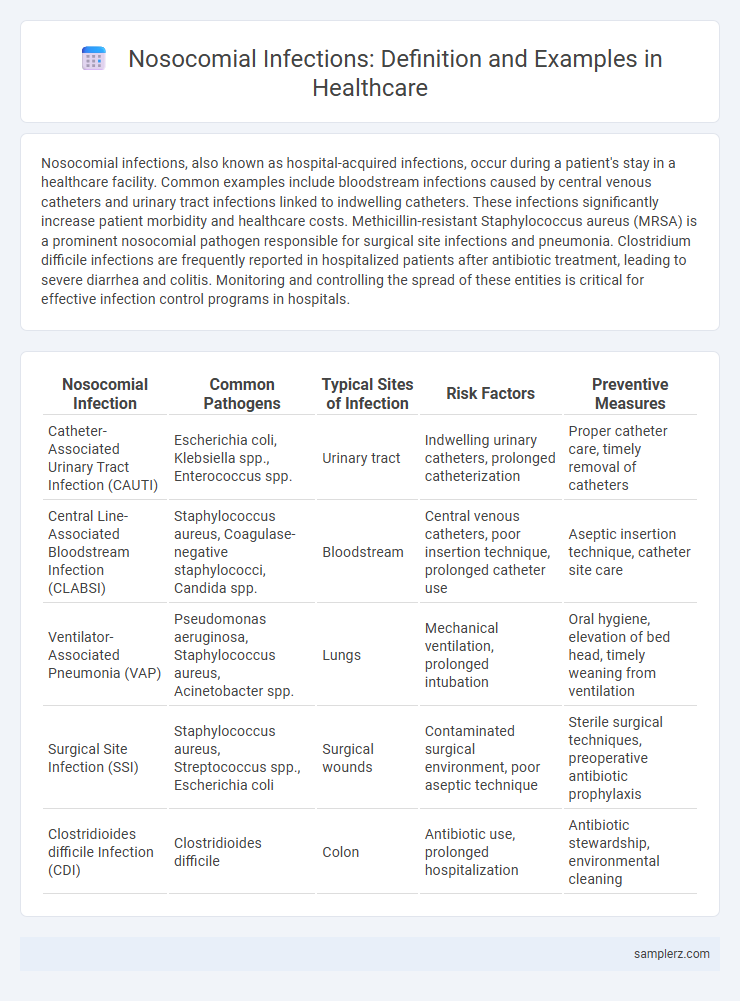Nosocomial infections, also known as hospital-acquired infections, occur during a patient's stay in a healthcare facility. Common examples include bloodstream infections caused by central venous catheters and urinary tract infections linked to indwelling catheters. These infections significantly increase patient morbidity and healthcare costs. Methicillin-resistant Staphylococcus aureus (MRSA) is a prominent nosocomial pathogen responsible for surgical site infections and pneumonia. Clostridium difficile infections are frequently reported in hospitalized patients after antibiotic treatment, leading to severe diarrhea and colitis. Monitoring and controlling the spread of these entities is critical for effective infection control programs in hospitals.
Table of Comparison
| Nosocomial Infection | Common Pathogens | Typical Sites of Infection | Risk Factors | Preventive Measures |
|---|---|---|---|---|
| Catheter-Associated Urinary Tract Infection (CAUTI) | Escherichia coli, Klebsiella spp., Enterococcus spp. | Urinary tract | Indwelling urinary catheters, prolonged catheterization | Proper catheter care, timely removal of catheters |
| Central Line-Associated Bloodstream Infection (CLABSI) | Staphylococcus aureus, Coagulase-negative staphylococci, Candida spp. | Bloodstream | Central venous catheters, poor insertion technique, prolonged catheter use | Aseptic insertion technique, catheter site care |
| Ventilator-Associated Pneumonia (VAP) | Pseudomonas aeruginosa, Staphylococcus aureus, Acinetobacter spp. | Lungs | Mechanical ventilation, prolonged intubation | Oral hygiene, elevation of bed head, timely weaning from ventilation |
| Surgical Site Infection (SSI) | Staphylococcus aureus, Streptococcus spp., Escherichia coli | Surgical wounds | Contaminated surgical environment, poor aseptic technique | Sterile surgical techniques, preoperative antibiotic prophylaxis |
| Clostridioides difficile Infection (CDI) | Clostridioides difficile | Colon | Antibiotic use, prolonged hospitalization | Antibiotic stewardship, environmental cleaning |
Understanding Nosocomial Infections: Definition and Scope
Nosocomial infections, also known as hospital-acquired infections (HAIs), are infections patients acquire during their stay in healthcare facilities, appearing 48 hours or more after admission. Common examples include catheter-associated urinary tract infections (CAUTIs), surgical site infections (SSIs), ventilator-associated pneumonia (VAP), and bloodstream infections (BSIs). Understanding the scope of these infections is critical for implementing effective infection control protocols and reducing morbidity and mortality rates in clinical settings.
Common Types of Nosocomial Infections in Healthcare Settings
Common types of nosocomial infections in healthcare settings include urinary tract infections (UTIs), surgical site infections (SSIs), bloodstream infections (BSIs), and pneumonia. Catheter-associated urinary tract infections (CAUTIs) and central line-associated bloodstream infections (CLABSIs) are particularly prevalent due to the invasive devices used in patient care. Proper hygiene protocols and sterilization techniques are essential to reduce the incidence of these hospital-acquired infections.
Methicillin-Resistant Staphylococcus Aureus (MRSA) Infections
Methicillin-Resistant Staphylococcus Aureus (MRSA) infections represent a significant example of nosocomial infections, commonly acquired in hospital settings due to resistant bacterial strains. MRSA primarily causes bloodstream infections, surgical site infections, and pneumonia among hospitalized patients, complicating treatment due to its resistance to standard beta-lactam antibiotics. Preventative measures such as strict hygiene protocols, contact precautions, and antibiotic stewardship are critical in reducing MRSA transmission and improving patient outcomes in healthcare facilities.
Catheter-Associated Urinary Tract Infections (CAUTIs)
Catheter-Associated Urinary Tract Infections (CAUTIs) represent a significant portion of nosocomial infections, accounting for over 30% of hospital-acquired infections in the United States. These infections arise from microbial biofilms forming on the indwelling urinary catheter surface, leading to complications such as bacteriuria, pyelonephritis, and sepsis. Implementing evidence-based practices, including aseptic catheter insertion and timely removal, is pivotal in reducing CAUTI incidence and improving patient outcomes in healthcare settings.
Hospital-Acquired Pneumonia (HAP) and Ventilator-Associated Pneumonia (VAP)
Hospital-Acquired Pneumonia (HAP) is a common nosocomial infection occurring 48 hours or more after hospital admission, with prevalence rates ranging from 5 to 20 cases per 1,000 hospital admissions. Ventilator-Associated Pneumonia (VAP), a subtype of HAP, develops in patients undergoing mechanical ventilation for more than 48 hours, affecting 10 to 20% of such patients and significantly increasing morbidity and mortality. Pathogens like Pseudomonas aeruginosa, Staphylococcus aureus, and Klebsiella pneumoniae are frequently implicated in both HAP and VAP infections.
Surgical Site Infections (SSIs): Causes and Risks
Surgical Site Infections (SSIs) are a common type of nosocomial infection caused by bacteria such as Staphylococcus aureus and Escherichia coli contaminating the surgical wound. Risk factors for SSIs include prolonged surgery duration, improper sterilization of surgical instruments, and patient factors like diabetes and obesity. Effective prevention strategies involve strict aseptic techniques, perioperative antibiotic prophylaxis, and maintaining optimal wound care post-surgery.
Clostridioides difficile (C. diff) Infections in Hospitals
Clostridioides difficile (C. diff) infections represent a significant example of nosocomial infections in hospitals, causing severe diarrhea and colitis primarily in patients undergoing antibiotic treatment. The spore-forming bacteria persist in the healthcare environment, contaminating surfaces and medical equipment, leading to high transmission rates among vulnerable patients. Effective infection control measures, including rigorous hand hygiene and environmental cleaning, are critical to reducing C. diff incidence in healthcare settings.
Central Line-Associated Bloodstream Infections (CLABSIs)
Central Line-Associated Bloodstream Infections (CLABSIs) are a prevalent type of nosocomial infection occurring in hospitalized patients with central venous catheters. These infections result from bacteria or fungi entering the bloodstream through the central line, leading to severe complications such as sepsis and increased hospital stays. Effective prevention strategies include strict adherence to aseptic techniques during catheter insertion and maintenance, as well as early removal of unnecessary central lines.
Fungal Nosocomial Infections: Candida and Aspergillus
Fungal nosocomial infections commonly involve Candida and Aspergillus species, which pose significant risks in immunocompromised hospital patients. Candida species, particularly Candida albicans, are frequent causes of bloodstream infections and candidemia, especially in intensive care units. Aspergillus, notably Aspergillus fumigatus, leads to invasive pulmonary aspergillosis, often affecting patients with prolonged neutropenia or those undergoing organ transplantation.
Preventive Strategies for Nosocomial Infection Control
Hand hygiene remains the cornerstone in preventing nosocomial infections, with healthcare workers rigorously using alcohol-based hand sanitizers or soap and water before and after patient contact. Implementation of strict sterilization protocols for surgical instruments and hospital environments significantly reduces the risk of pathogen transmission. Regular surveillance and isolation of infected patients further contain outbreaks of multidrug-resistant organisms within healthcare settings.

example of nosocomial in infection Infographic
 samplerz.com
samplerz.com